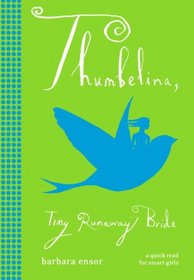Reviewed by Steph for TeensReadToo.com
Many know the story of Thumbelina. She is a very tiny girl who one day went on the adventure of a lifetime. She met toads, a mouse, a mole, and a swallow.
She also met her true love -- the little king of the flowers.
Barbara Ensor takes the classic story and makes some changes of her own, based on her logic of how the story should end.
This easy and fast read will be very entertaining to readers of all ages. With only about 150 pages, the reader can learn the entire story of Thumbelina in a short time. The story flows from one scene to another, bringing the classic character of Thumbelina to life.
Readers are sure to enjoy this fascinating story re-created by Ms. Ensor.
Many know the story of Thumbelina. She is a very tiny girl who one day went on the adventure of a lifetime. She met toads, a mouse, a mole, and a swallow.
She also met her true love -- the little king of the flowers.
Barbara Ensor takes the classic story and makes some changes of her own, based on her logic of how the story should end.
This easy and fast read will be very entertaining to readers of all ages. With only about 150 pages, the reader can learn the entire story of Thumbelina in a short time. The story flows from one scene to another, bringing the classic character of Thumbelina to life.
Readers are sure to enjoy this fascinating story re-created by Ms. Ensor.
I love Hans Christian Andersen's stories, but his poor little girls are like delicate figurine studies in pathos: they're exquisite, but not very much like people. In this book, Ensor takes his character Thumbelina and retells the story from her point of view. Here, Thumbelina is a full and interesting character who wants to know about the world and goes on an accidental adventure. My only disappointment is that she was snatched while she wasn't carrying her tiny bow and arrows, but I guess every book can't be The Hunger Games. ;-)
I read this book aloud with a seven-year-old, and it raised some interesting questions. Probably because of said seven-year-old, I find it unsettling to read stories where interesting people fall into unfortunate circumstances and end up as unwilling brides to creepy rodents. Can't every story about a happy young girl just talk about how she worked really hard and got into college? (No, they can't.)
My co-reader, on the other hand, loved it. She drank it all in and even re-read some of the chapters in between the times we read together. The original story provided romance and drama, and Ensor replaced the delicate, sad, passive, helpless little magic girl that Andersen wrote with a realistic person with her own flaws and opinions. For me, this made the story more exciting and engaging.
If I could change anything, I would have asked Ensor to go smoothly through to her own ending instead of awkwardly detouring though Andersen's. I think that by that point in the book she had taken Thumblina over entirely, and as a reader I expected drastic changes in her retelling. I don't think she owed the original story anything, although it was nice how much she mentions Andersen in the book.
The illustrations, which are paper cutouts, are lovely. Reading Thumbelina's beautiful journal entries makes the reader feel more intimate with her. Overall, I would recommend this book.
I read this book aloud with a seven-year-old, and it raised some interesting questions. Probably because of said seven-year-old, I find it unsettling to read stories where interesting people fall into unfortunate circumstances and end up as unwilling brides to creepy rodents. Can't every story about a happy young girl just talk about how she worked really hard and got into college? (No, they can't.)
My co-reader, on the other hand, loved it. She drank it all in and even re-read some of the chapters in between the times we read together. The original story provided romance and drama, and Ensor replaced the delicate, sad, passive, helpless little magic girl that Andersen wrote with a realistic person with her own flaws and opinions. For me, this made the story more exciting and engaging.
If I could change anything, I would have asked Ensor to go smoothly through to her own ending instead of awkwardly detouring though Andersen's. I think that by that point in the book she had taken Thumblina over entirely, and as a reader I expected drastic changes in her retelling. I don't think she owed the original story anything, although it was nice how much she mentions Andersen in the book.
The illustrations, which are paper cutouts, are lovely. Reading Thumbelina's beautiful journal entries makes the reader feel more intimate with her. Overall, I would recommend this book.




